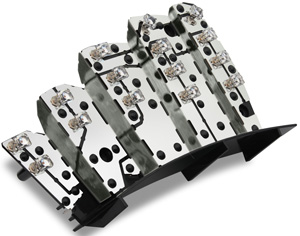- News
14 March 2011
Lumileds improves SnapLED array for automotive lighting
Philips Lumileds of San Jose, CA, USA says that it has significantly improved its SnapLED, which it claims is the automotive industry’s most widely used LED for signaling applications.
With a continued focus on reliability and performance, engineers have raised junction temperature maximums, narrowed color binning to levels imperceptible by the human eye, dual-binned for drive current to simplify the design process and make it easier to meet critical regulation requirements, and implemented a new Multi-Environment Over Stress Test (MEOST) regimen to ensure that SnapLED is the most reliable automotive LED.
 “A ‘build out of the box’ approach to turn, tail, and stop lighting applications on vehicles is a major step forward for the auto industry and significantly reduces engineering and development costs,” claims Scott Kern, strategic & product marketing. “We remove the need for re-testing and screening, which can save our customers more than 5% of operational costs, reduce equipment and manpower needs, speed production, and improve finished goods yields,” he reckons. “We continue to lower system costs and barriers to adoption.”
“A ‘build out of the box’ approach to turn, tail, and stop lighting applications on vehicles is a major step forward for the auto industry and significantly reduces engineering and development costs,” claims Scott Kern, strategic & product marketing. “We remove the need for re-testing and screening, which can save our customers more than 5% of operational costs, reduce equipment and manpower needs, speed production, and improve finished goods yields,” he reckons. “We continue to lower system costs and barriers to adoption.”
Picture: Lumileds’ SnapLED array for a rear combination lamp.
SnapLED’s maximum junction temperature has been increased to 135°C (the industry’s highest for a mid-power LED, it is claimed), widening the design envelope and giving engineers more flexibility in their design efforts as they create new lighting solutions.
Flux bin sizes (which were already quite small) have been reduced by as much as 67% so that flux variations within a bin are imperceptible to the human eye. Simultaneously, the forward voltage bin widths have been reduced by as much as 50%, making the use of low-cost, resistor-based driver circuits easier to implement. SnapLED is also designed to operate over a dynamic current range of 30:1, allowing for simplified, yet reliable, designs for both stop- and tail-mode operation.
LEDs in stop-tail signaling lamps tend to operate at the extremes of current limits, and most have difficulty meeting the performance and uniformity requirements without expensive electrical designs. With SnapLED’s dual binning, flux ratios between different current levels and uniformity across the entire dynamic range are highly controlled. This precision makes it easier to implement a solution with confidence — without the need for re-testing LEDs prior to assembly — as the uniformity and flux performance are already narrowly defined, says Lumileds.
The new MEOST regime, which exceeds the testing required by existing standards for automotive signaling LED sources. It exceeds AEC-Q101, including simulations for extreme operational conditions as well as tests that far exceed datasheet guidelines and maximums, SnapLED LEDs should function reliably for the life of the vehicle, concludes Lumileds.
Lumileds Automotive LEDs SnapLED
Join Semiconductor Today's LinkedIn networking and discussion group
